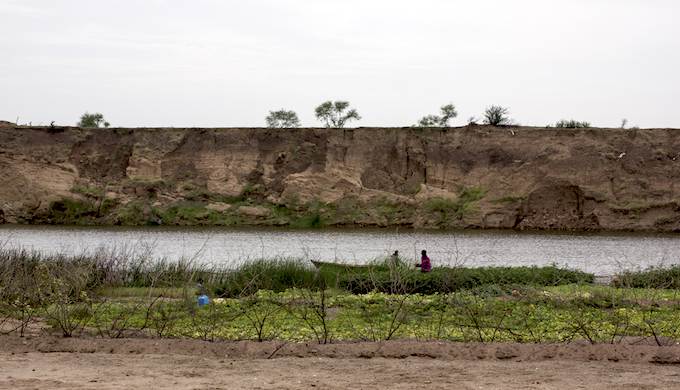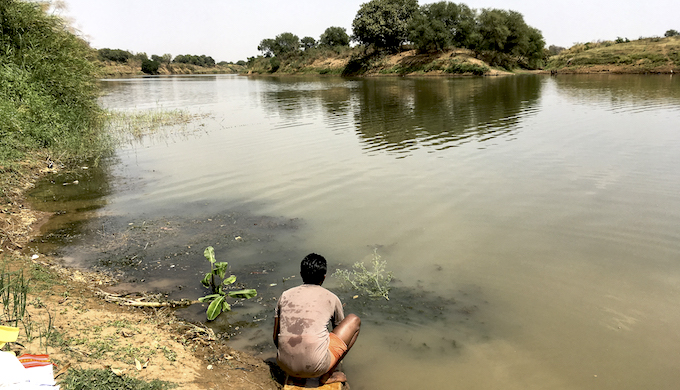This multi-media report by Siddharth Agarwal based on a walk along the majestic Ken River in central India, now part of a contentious river-linking project, shows how essential it is to the communities living around it.
The idea of walking along a river has many key reasons, but the most important of them is to interact, discuss with and document the life of the actual stakeholders of this natural system. Traversing flood plains and riverbanks on foot takes us right where the story is, not in a far removed space, where even a few kilometres away from it can be a major shift. Location plays a wonderful role in rejigging memory and helps people imagine past situations. The discussions on the scale of the importance of a river suddenly have a realism and depth.

We decided to walk along the largely unexplored, undocumented and rather fabulous Ken River, while realising the imminent threat posed by proposed large-scale projects on it. The Ken is part of India’s first river-linking project that has been opposed by experts and environmentalists.
The Ken-Betwa Link Project aims to transfer surplus water from the Ken River basin to Betwa River basin to irrigate 343,000 hectares in water-deficient areas of Bundelkhand spread across Madhya Pradesh and Uttar Pradesh. It is expected to cost around INR 180 billion (USD 2.6 billion), which includes building a canal and a dam across the Ken River that will drown portions of the Panna National Park in central India, a crucial habitat for tigers. Environmentalists and water experts have opposed the project. See: Linking rivers will not save Bundelkhand.
Information gathered from the field transformed our perspective. It explained the utility of seemingly simple activities, brought river science to life and convinced us of the futility of large-scale projects. These projects completely ignore the very basics of environmental and local knowledge, rights of riparian communities, and most of all, the abysmal present situation of the river.

When my companion Bhim Singh Rawat and I started our walk along the Ken, our minds were tuned to look out for different ecosystem activities around the river, including riverbed farming. The next few hundred kilometres would take us close to the lives of those undertaking this age-old practice, taking advantage of the gifts of nature and at times trying to balance the inequalities they suffer through the accident of birth.

Turning to the river
Those who do not own land turn to the river, sometimes getting land without payment and at other times having to pay those who have leases for plots close to the river. It is a complicated calculation given the meandering nature of rivers, which do not obey Cartesian boundaries. This can often get village councils, police and politicians involved. Once it eventually does play out, life on the edge of the river appears beautiful, at least from the outside.
Changing cropping patterns, reduced forest cover, heavy sand mining and increasing population are constantly increasing water stress in Bundelkhand’s districts along the Ken River.

However, even in the face of such adverse situations, when large stretches of the river were found to be dry much before summer had officially set in, we could spot small and large pools in the river.

The relationship of groundwater with rivers is quite often misunderstood, because most people assume that it is rivers that feed groundwater. But those living for centuries in close proximity to rivers know better. These pools are formed by accumulation of groundwater released slowly by springs into the riverbed.
A phenomenon that otherwise remains invisible is brought out into the open because we’ve sucked away all the surface water that the river had to otherwise offer for farming. This river science is clearly visible because everything is dry.

And then after all the extraction when there is nothing left to exploit and the summer season is just weeks away, these pools are protected for the harsh times ahead.
The report excluding feature image has been previously published by India Climate Dialouge and is based on Ken River Yatra organised by the South Asia Network for Dams, Rivers & People (SANDRP) and Veditum India Foundation. For more information, please contact: Siddharth Agarwal (Veditum): 100170707, asid@veditum.org, http://veditum.org/, Bhim Singh Rawat (SANDRP) : 9717957517, bhim.sandrp@gmail.com, https://sandrp.in/
You may also like to read other interesting reports based on Ken River Yatra 2017-18.
अनुपम केन नदी पदयात्रा का यादगार अनुभव
Amazing experience of Yatra along the Majestic Ken River
Ken River Yatra: Exploring A Threatened River And Knowing River People

Hi there,
My name is Annwyn and I am an undergraduate Environmental Science student at Wageningen University in the Netherlands.
Four other students and I are conducting a case study about the Inter-Linking Rivers Project, specifically the Ken-Betwa link.
I was wondering if you had any time to meet with us virtually to help us better understand the local communities’ concerns in the project. If you know of someone else that I could contact instead, that would also help greatly.
my email is annwyn.murray@wur.nl
Thank you, Annwyn Murray
LikeLike